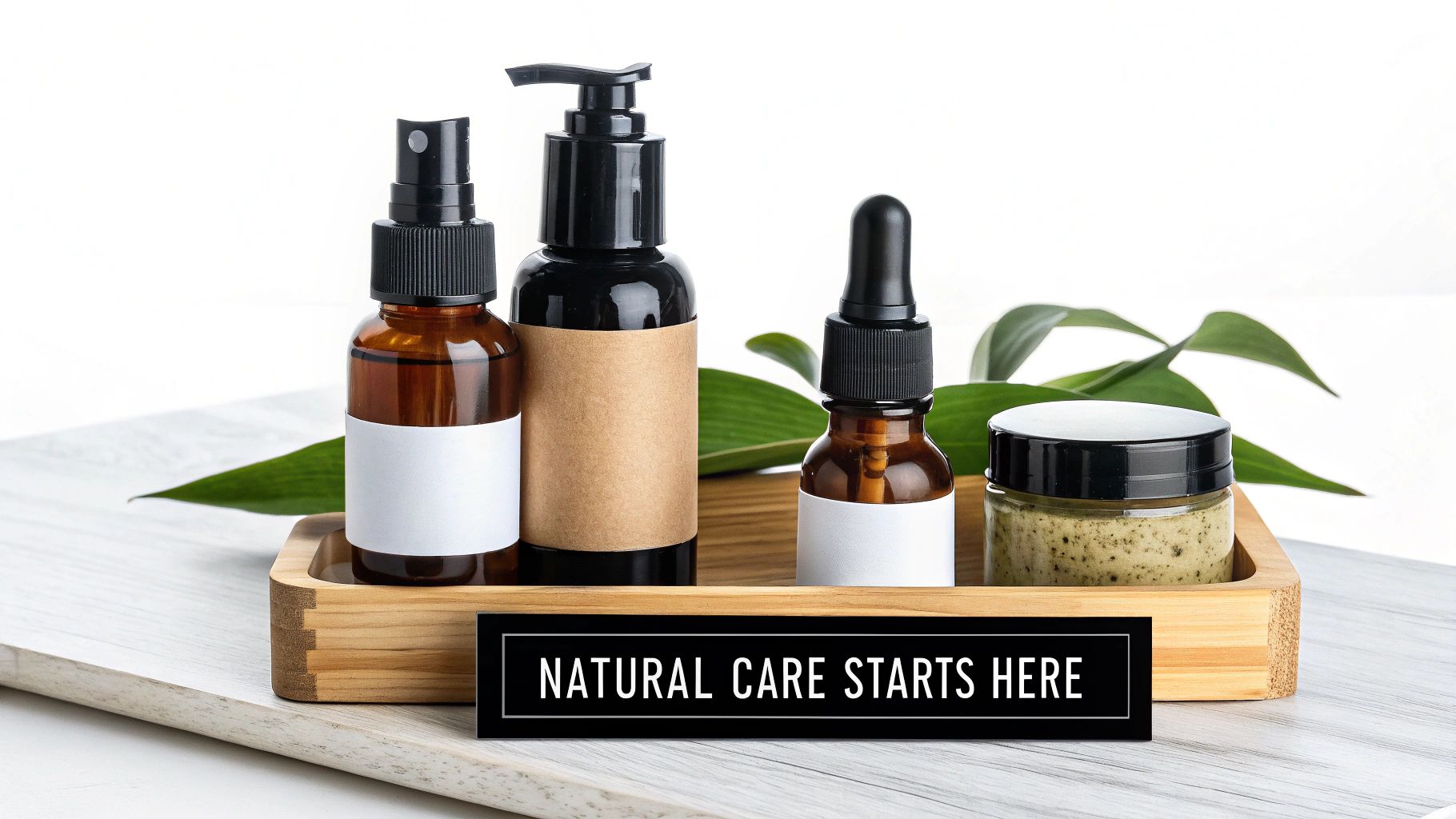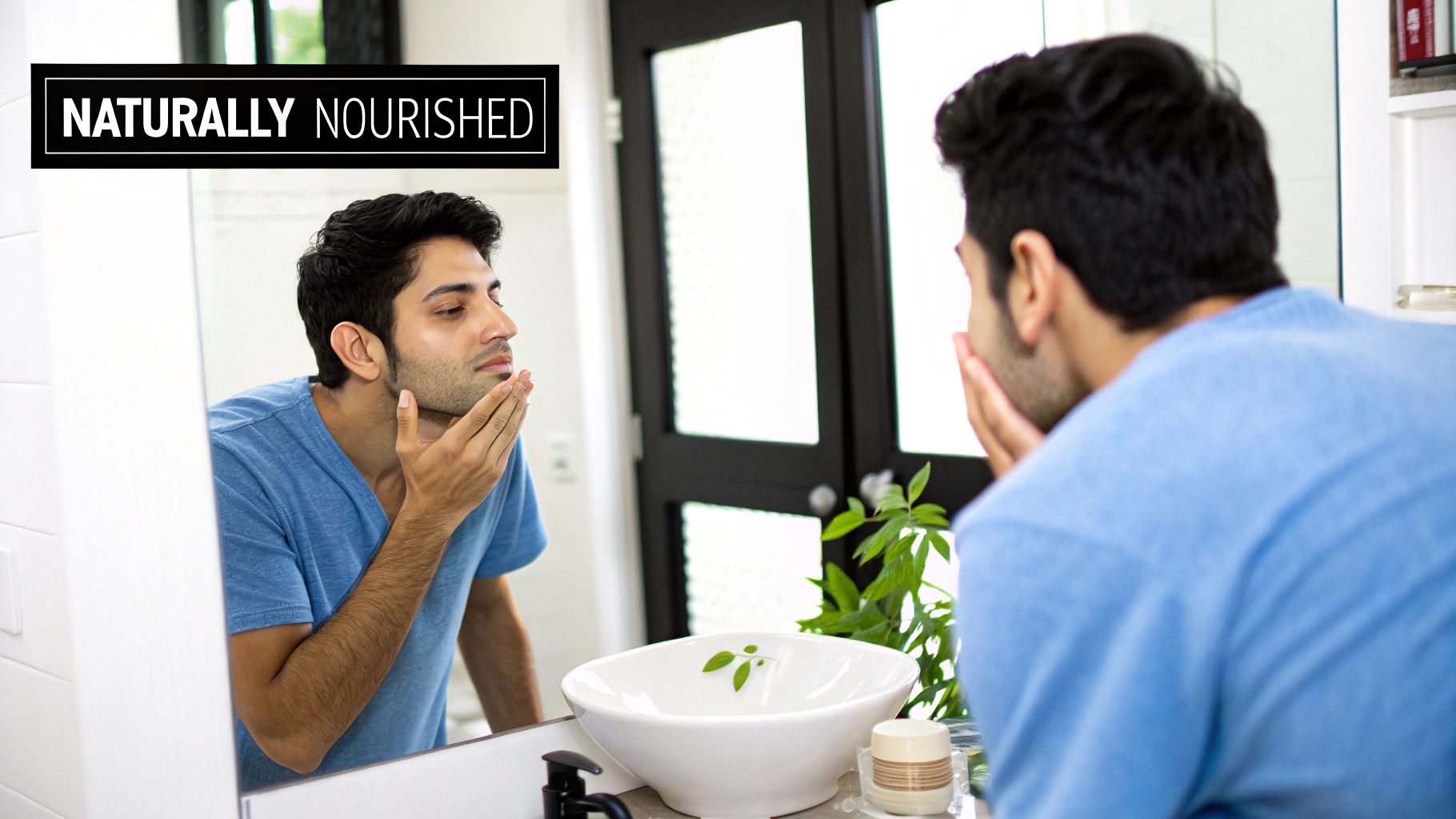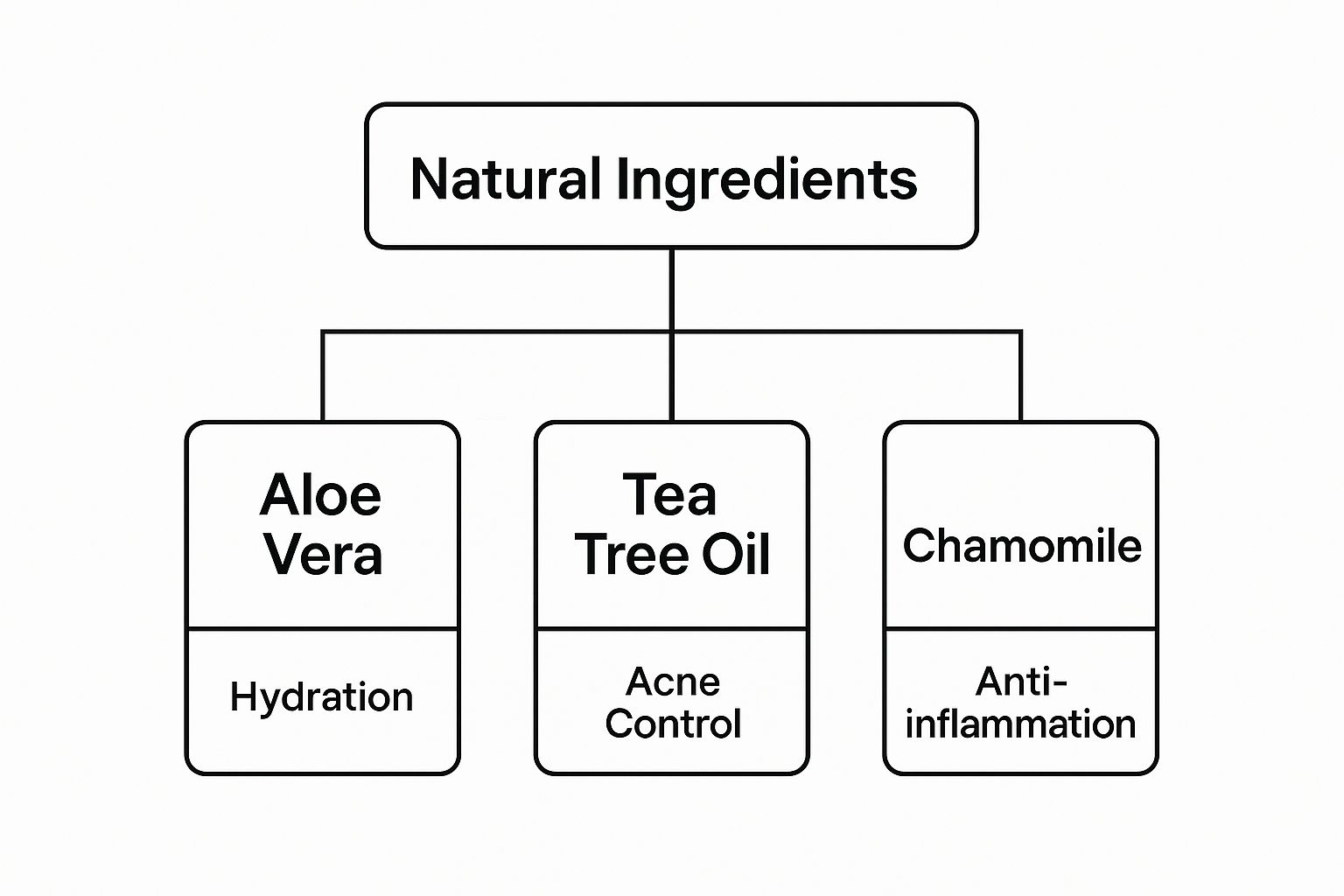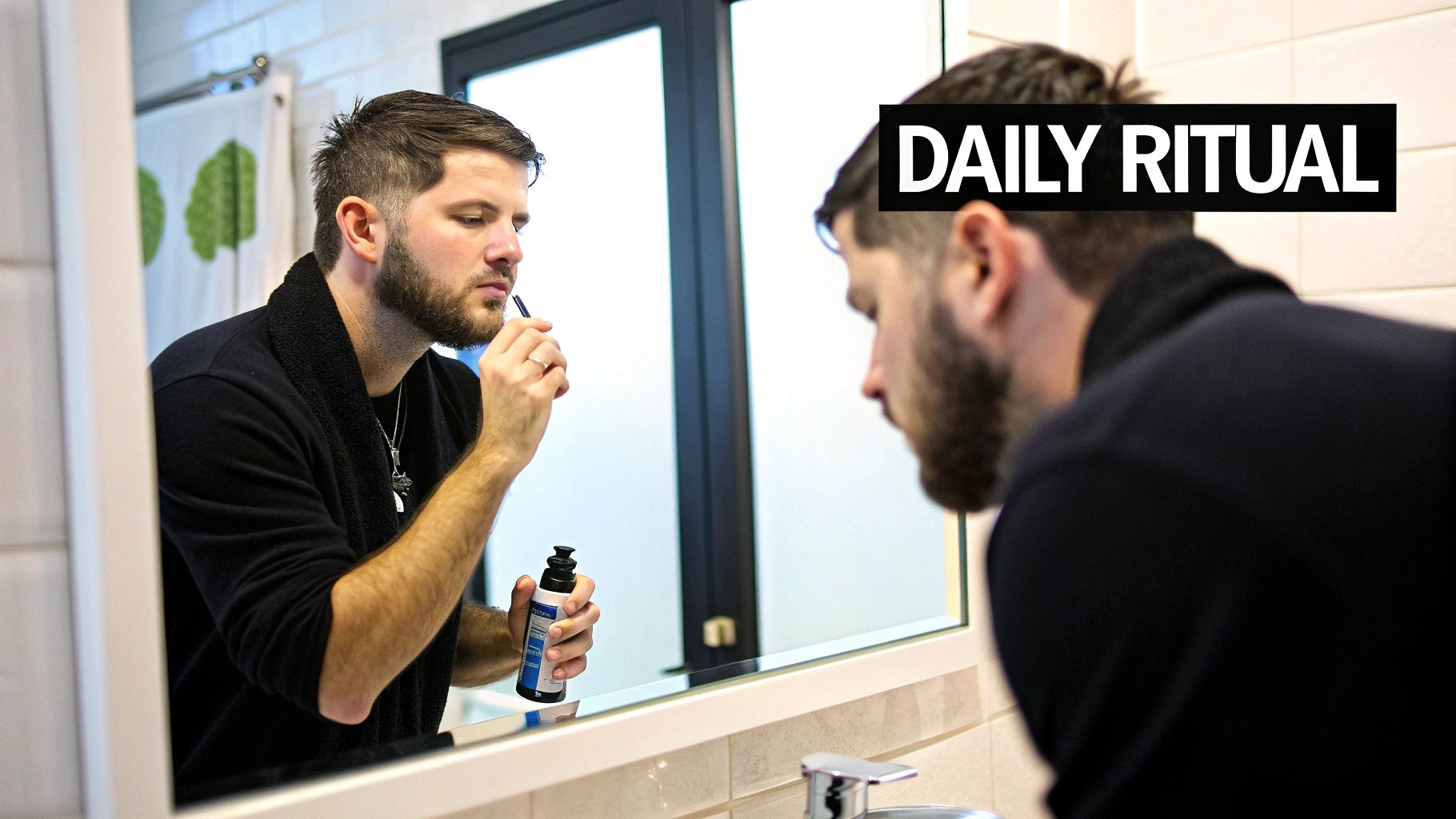Jan Elvis
28.09.2025

Jan Elvis
28.09.2025
Making the switch to natural skincare isn't about vanity—it's about making a long-term investment in your skin's health. You wouldn't fuel your body with junk food, right? The same logic applies to what you put on your face. This guide will walk you through building a simple, effective routine that actually works, without any of the confusion.

Let's be honest, the move toward natural skincare isn't just another passing trend. It's a real shift in how guys are thinking about their health and wellness. For a long time, the go-to routine was a harsh bar of soap and maybe, if you were feeling fancy, some random lotion. But as we've gotten smarter about how our skin works, the demand for cleaner, better options has exploded.
It makes perfect sense. Men's skin is built differently than women's—it's generally thicker, produces more oil, and has larger pores. On top of that, daily shaving can be brutal, leading to constant irritation, razor burn, and ingrown hairs. So many conventional products are loaded with synthetic chemicals, alcohols, and fake fragrances that strip away your skin's natural moisture, which just kicks off a vicious cycle of dryness and excess oil.
Today's guy is more plugged in and intentional about the products he buys. This shift in thinking has sent the men's grooming market soaring, with projections showing it will grow from USD 16.28 billion in 2024 to USD 23.34 billion by 2030. Natural formulas are leading the charge as more men look for results without the questionable ingredients. You can get more details on the growth of the men's skincare market from industry reports.
Natural skincare for men is simply a smarter way to go. Instead of waging war on your skin with harsh chemicals, these products work with its natural biology.
Think of it this way: conventional skincare often acts like a quick fix, slapping a bandage on a problem. Natural skincare is more like foundational maintenance, strengthening your skin from the inside out so it can handle whatever life throws at it.
At the end of the day, going natural is about making a deliberate choice for quality and health. It’s about creating a simple, powerful routine that leaves your skin feeling balanced, healthy, and genuinely looked after. And that's exactly what this guide will help you build.

Let's be honest: walking down the skincare aisle feels like you're being bombarded with marketing hype. You see words like "natural," "pure," and "plant-based" on almost every bottle. But what do they really mean? The surprising answer is… not a whole lot, at least not officially.
Here’s the thing: the term "natural" isn't regulated by the FDA when it comes to cosmetics. That little detail gives brands a ton of wiggle room. A product can be labeled "natural" even if it only has a tiny amount of a plant extract mixed in with a long list of synthetic chemicals. This sneaky tactic is called greenwashing—making a product seem way healthier and more eco-friendly than it is.
This is exactly why learning to read an ingredient list is the single most powerful skill you can have. It’s your secret weapon for cutting through the noise and understanding what you’re really putting on your skin. Think of it like a food label: the ingredients at the very top are what make up most of the product.
That list of tiny words on the back of the bottle is called the INCI (International Nomenclature of Cosmetic Ingredients), and it’s your roadmap. Ingredients are always listed from the highest concentration to the lowest. So, if water (Aqua) is the first thing you see, that’s what the bottle is mostly full of.
When you're searching for a genuinely natural product, you want to see recognizable, plant-based ingredients dominating the top of that list. This is your first and best clue that the brand is building its formula on real, beneficial stuff, not just cheap fillers.
Here’s the kind of good stuff you want to see up top:
If the first five ingredients are things you can actually pronounce and recognize from nature, you’re probably on the right track. It shows a real commitment to quality.
Knowing what to look for is half the battle; knowing what to avoid is the other half. A lot of conventional men's products rely on cheap, harsh synthetics that can throw your skin's natural balance completely out of whack, often causing the exact problems you're trying to fix—like dryness, irritation, and breakouts.
Keep an eye out for these common offenders:
Look, the goal isn't to become a cosmetic chemist overnight. It’s about learning to spot the patterns. If you see a label packed with long, unpronounceable chemical names at the top and a sprinkle of "botanical extract" at the very bottom, that’s a huge red flag.
When you start prioritizing products with simple, powerful, and recognizable ingredients, you take back control. You’re no longer falling for marketing tricks; you’re making a smart choice for your skin's long-term health.
Okay, so you've learned how to read a label. The next logical step is figuring out which ingredients you actually want to see on there.
Think of it like this: natural ingredients are your toolkit, and each one has a very specific job. Forget trying to memorize a long list of scientific names. Instead, let’s focus on the problem you're trying to solve. Is your skin feeling dry and tight? Are you fighting off breakouts? Or maybe just trying to calm down that post-shave irritation?
For every one of those common issues, nature has a powerful answer. The trick is simply matching the right tool—the right ingredient—to your specific skin concern. When you approach it this way, building a routine with natural skin care products for men becomes incredibly straightforward and, more importantly, effective.
And it seems a lot of guys are catching on. The demand for targeted, natural solutions is booming. Products built around natural ingredients are a huge part of the men's skincare world, with organic formulas accounting for a massive 64.3% of the market share in 2024. Facial care leads the charge, holding about 58.2% of the market, which tells you that cleansers and moisturizers packed with botanical extracts are exactly what men are looking for.
This visual guide breaks down some of the most effective natural ingredients based on the problem they solve.

As you can see, certain botanicals are true specialists, from the intense hydrating power of aloe vera to the incredible soothing properties of chamomile.
Let’s dive a bit deeper into some of the best ingredients for common skin goals. We've put together a quick-reference table to highlight a few of our favorites.
| Ingredient | Primary Benefit | Best For Skin Type |
|---|---|---|
| Aloe Vera | Soothes and hydrates without oiliness | All, especially oily and sensitive |
| Tea Tree Oil | Fights acne-causing bacteria | Oily and acne-prone |
| Chamomile | Calms redness and inflammation | Sensitive and irritated |
| Hyaluronic Acid | Deeply hydrates and plumps skin | All, especially dry and combination |
| Calendula | Heals and repairs damaged skin | All, especially after shaving |
| Witch Hazel | Tones and reduces excess oil | Oily and combination |
This table is a great starting point, but let's break down why these ingredients are so effective for specific problems you might be facing.
A classic mistake guys with oily skin make is skipping moisturizer, thinking it'll just add to the problem. The opposite is often true. When your skin is dehydrated, it can actually ramp up oil production to compensate. The fix? Lightweight hydration that absorbs quickly and won't clog your pores.
If you’re constantly dealing with a shiny forehead or surprise blemishes, you need ingredients that can get oil production under control and fight bacteria without being overly harsh. Aggressive, alcohol-based acne products often just make things worse by irritating your skin.
A lot of guys think fighting oil means you have to dry your skin out until it squeaks. The real goal is balance. Natural ingredients like witch hazel help regulate oil production rather than just stripping it all away, which stops your skin from panicking and producing even more oil.
For many of us, shaving is the biggest source of skin irritation, leading to redness, razor burn, and general sensitivity. The right natural ingredients can offer instant relief and help make your skin more resilient over time, thanks to their anti-inflammatory properties.
And remember, a natural approach doesn't have to stop with your face. Applying these principles to your entire grooming routine can make a world of difference. If you're looking for more tips on staying fresh, check out our guide on how to smell good naturally.

Picking the right ingredients is a massive win, but it’s really only half the battle. Even the best natural stuff on the planet won't do much if it’s not right for your skin. This is where figuring out your skin type changes everything.
Think of it this way: you wouldn't put diesel in a Ferrari. Both are fuel, but they’re built for entirely different engines. Your skin is no different. A heavy-duty moisturizer designed for parched, dry skin will just feel like a greasy slip-n-slide on someone with an oily complexion.
Knowing your skin type is the bedrock of a good routine. It’s what lets you stop guessing and start choosing natural skin care products for men that will actually get the job done. The best part? You don't need a dermatologist or any weird gadgets to figure it out.
One of the most straightforward and time-tested ways to find out your skin type is what’s known as the bare-face method. It costs nothing, is incredibly simple, and just requires a little bit of patience.
Here’s the game plan:
This little waiting period gives your skin a chance to show its true colors without any products getting in the way.
Alright, time to play detective. Now that your skin has had a moment to reset, you can figure out what it's trying to tell you. Your face will almost always fall into one of these five main categories.
Identifying your skin type is your personal roadmap. It allows you to select ingredients that work in harmony with your skin's biology, rather than against it. A guy with oily skin needs Witch Hazel to balance oil, while someone with dry skin should reach for Shea Butter to replenish it.
Once you know what you’re working with, you can go back to that list of powerhouse ingredients and confidently choose the ones that will bring your skin into balance. This is how you build a routine that actually delivers.
Alright, you've figured out your skin type and know which natural ingredients to look for. Now it’s time to actually put that knowledge to work. Forget those insane 12-step routines you see all over social media. When it comes to great skin, consistency always beats complexity.
A solid, sustainable routine really only needs four simple pillars. This framework is designed to be fast, effective, and easy to stick with, even on your craziest days. Think of it as the foundation for your skin's health.
This routine covers every essential base your skin needs to look and feel its best. Each step serves a distinct purpose, and they all work together to give you a balanced, healthy complexion. Let's break down each one.
1. Cleanse: The Essential First Step
The goal here is simple: wash away the dirt, sweat, and gunk that builds up on your face without stripping it of its natural moisture. A good cleanse is like hitting the reset button, creating a clean canvas for everything that comes next.
2. Treat: Target Your Specific Concerns
This is where you get to customize your routine. A treatment product, usually a serum, is basically a concentrated shot of active ingredients designed to tackle a specific problem head-on. Because serums are so lightweight, they sink deeper into the skin to deliver real results.
3. Moisturize: Lock in Hydration
Moisturizing is completely non-negotiable, no matter your skin type—yes, even if you have oily skin. A good moisturizer does two critical jobs: it hydrates your skin by adding water back into it, and it creates a protective barrier on the surface to keep that moisture from escaping.
4. Protect: Your Best Defense Against Aging
If you do only one thing for your skin’s long-term health, make it this. Sunscreen is your number one weapon against premature aging, dark spots, and, most importantly, skin cancer. Slap on a broad-spectrum SPF 30 or higher every single morning. Rain or shine. No excuses.
This four-step routine might seem basic, but when you do it consistently morning and night, it’s incredibly effective. You're giving your skin exactly what it needs to perform at its best. For a deeper dive into how to structure your daily regimen, check out our complete skincare routine for men guide.
This isn't just a niche hobby anymore; taking care of your skin is becoming the norm. The men's skincare market is projected to explode from around USD 17.6 billion in 2025 to over USD 37.3 billion by 2035, all because more guys are finally wising up to the importance of skin health.
Remember, the goal isn’t perfection; it’s progress. Sticking to a simple, effective routine will get you far better results than a complicated one you only do once in a while. Make it a non-negotiable part of your morning and evening, just like brushing your teeth. Your skin will thank you for it.
Making the move to natural skin care products for men is a solid choice, but it's totally normal to have a few questions before you dive in. Let's tackle some of the most common things guys wonder about so you can feel good about starting your new routine.
Think of this as the real-world FAQ—the stuff you actually want to know before making a change.
This is where patience really pays off. Unlike a lot of synthetic products that give you a quick, superficial fix, natural ingredients work with your skin to build lasting health from the ground up. You’ll probably notice your skin feeling calmer and more hydrated within the first 1-2 weeks.
But for the big stuff—like clearer skin, a more even texture, or fewer breakouts—you need to give it at least one full skin cycle. That’s the 28-40 days it takes for your skin to completely regenerate. Sticking with it consistently is what gives these powerful ingredients the time they need to truly rebalance and fortify your skin.
Great question, and the answer is a hard no. It’s a huge distinction. The term "natural" isn't regulated in the beauty industry, which means a company can slap it on a label even if there's only one plant extract mixed in with a bunch of synthetic stuff.
"Organic," however, is a tightly controlled term. For a product to get that label, its ingredients have to be grown and processed without any synthetic pesticides, GMOs, or chemical fertilizers.
Think of it like this: all organic ingredients are natural, but not all natural ingredients are certified organic. If you're looking for the absolute purest stuff, keep an eye out for an official USDA Organic seal.
You bet. Just because something grows on a tree doesn't mean it agrees with everyone's skin. People have allergies to natural things like nuts and pollen all the time, and skincare is no different. Certain essential oils, for example, can be a bit much for guys with really sensitive skin.
This is exactly why a patch test is non-negotiable. Before you go all-in with a new product, dab a small amount on a spot like your inner arm or behind your ear. Give it 24 hours and see if any redness or irritation pops up. It's a simple step that can save you a lot of grief. For other common skin irritations, it also helps to learn how to prevent ingrown hairs with the right approach.
You've probably noticed that some natural products have a higher price tag, and it really comes down to "you get what you pay for." It costs more to ethically source high-quality botanicals and cold-press oils than it does to mass-produce synthetic chemicals in a lab.
The upside? Natural products are often way more concentrated. They aren't bulked up with cheap fillers, so a little bit goes a long way. That bottle will likely last you a lot longer than you think. It's less of an expense and more of an investment in your skin's future.
Ready to make the switch with confidence? The Main Character collection is built on powerful, effective ingredients to help you build a routine that works. Explore our range of products designed for men's skin.